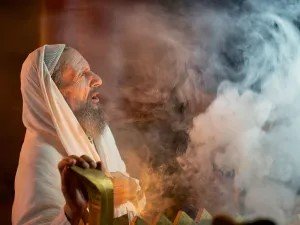Matthew 21:1-11
I saw a great movie a few years ago called “War Horse.” It was about a young man and his horse, who was taken to be used by the British army during World War I. The horse was a beautiful animal, and there were incredible scenes that demonstrated his intelligence. But there were also horrific scenes portraying the battlefield and the brutal way in which the horses were treated as they pulled heavy artillery pieces. The three other women who went with me to watch the movie kept covering their eyes during these scenes, and they were very hard to watch. But it helped knowing that no horses were actually mistreated or harmed during the making of the movie.
It wasn’t always like that. Back in the early days of Hollywood, animals were seen as cheap and disposable props on the movie sets. As movies were being made, horses were shocked, tripped, and forced to run into trenches. Wires were strung around their ankles and then yanked by the riders to make the horses fall on cue. During the making of the original Ben Hur in 1924, six horses were killed. And in the making of The Charge of the Light Brigade in 1935, twenty-five horses were killed or euthanized. But all that changed when an organization known as the American Humane Association was formed and opened an office in Hollywood to enforce standards for the protection of animals.
During the 1950s, the American Humane Association began an annual PATSY Award ceremony, honoring the Performance Animal Top Star of the Year. It is kind of like the Academy Award for animal actors. Francis the Mule was the first PATSY Award winner in 1951. Other winners include Roy Rogers’ horse, Trigger, and Arnold the Pig, from the TV show, “Green Acres.” In 1973 an Animal Actors’ Hall of Fame was established, and Lassie was the first inductee.
If the PATSY Award had been around in the first century, then surely the donkey who carried Jesus into Jerusalem on Palm Sunday would have been a winner. That donkey definitely played his part well.
Jerusalem was filled with people that day, pilgrims who had come from all over the world to celebrate Passover. Crowds milled around in the streets, overflowing out of the inns into the surrounding villages, and pressing toward the Temple to see the center of their faith, the place where they believed God dwelled.
Jesus was prepared to face whatever was waiting for him in Jerusalem. He knew that he was going to be put to death by the religious authorities, with whom he had been in conflict for most of his three-year ministry. But he did not enter the city quietly, under cover of darkness. Instead, he came in with the unmistakable air of a messiah, a savior, a king, riding on the back of a borrowed donkey.
It was a Hollywood spectacular. The crowds surrounded him and followed him into the city, waving palm branches in the air, and placing their cloaks on the ground before him. They shouted, “Hosanna!” at the top of their lungs, and “Blessed be the one who comes in the name of the Lord!” And the donkey must have pranced along with a spring in his step, responding to the excitement of the crowd.
If we were to look for a role model on that day, we would not have had much luck among the human population. Who would we choose as our example?
Well, we might consider the disciples of Jesus. After all, they had been following him for three years, learning from his teaching, being sent out on mission trips of their own and performing miracles. But they had also been unable to really grasp who Jesus was and what he was sent to do. On the way to Jerusalem, they had been arguing about who would be the greatest when Jesus established his kingdom on earth. They didn’t like listening to Jesus talk about his suffering and death. And in just a matter of days, one of them would betray him, one would deny him, and all would desert him.
There are some people today who are a lot like the disciples. They have followed Jesus for years, attending church, putting their offering in the plate, attending Bible study, maybe singing in the choir, visiting the shut-ins, serving on a committee. But when following Jesus calls for serious commitment or real sacrifice, they seem to vanish.
Clarence Jordan founded the Koinonia Farm near Americus, Georgia in the early 1950s. It was intended to be an interracial community, long before anyone knew what civil rights was all about. Jordan himself was a pacifist as well as an integrationist, and was not very popular in Georgia, even though he came from a prominent family there. The Koinonia Farm was very controversial and was always in some kind of trouble.
One day Clarence went to his brother, Robert, who was later to be elected as a state senator and then serve as a justice on the Georgia Supreme Court. Clarence needed legal representation for the Koinonia Farm, because they were having trouble getting LP gas delivered for heating during the winter, even though it was against the law not to deliver the gas. Clarence thought that Robert might possibly be able to solve the problem with just a phone call. But Robert said to him, “Clarence, you know I can’t do that. I’ve got political aspirations. If I represented you, I might lose my job, my house, everything I’ve got.”
Clarence responded, “We might lose everything, too.” Robert answered, “It’s different for you.” Clarence said, “Why is it different? I remember that you and I joined the church on the same Sunday as boys. I believe that when we came forward the preacher asked you the same question as he asked me: ‘Do you accept Jesus as your Lord and Savior?’ I said, ‘Yes.’ What did you say?”
Robert replied, “I follow Jesus up to a point, Clarence.” “Could that point be the cross?” asked Clarence. “That’s right. I follow him to the cross, but not on the cross. I’m not going to get myself crucified.” Clarence said, “Then I don’t think you’re really a disciple. You’re an admirer of Jesus, but not a disciple. I think you ought to go back to your church and tell them you’re just an admirer, not a disciple.” Robert responded, “Well, if everyone who felt like I do did that, we wouldn’t have a church, would we?” Clarence said, “The question is, Do you have a church?”
No, I don’t think the disciples of Jesus are our choice of role model on Palm Sunday.
What about the people in the crowd? Maybe we would do better to look to them for our inspiration. They were shouting, “Hosanna!” when Jesus arrived in Jerusalem. It looked like they were willing to follow him anywhere. But no, maybe not. I seem to remember that the same people who shouted, “Hosanna!” on Sunday were shouting “Crucify him!” on Friday. They may have been curious about Jesus, but they were not committed to him. They may have known something of the truth about Jesus, but they were not prepared to do the truth. They were like college students who make an A in their ethics class, but still flunk living an ethical life themselves.
Of course, Jesus can still attract a crowd. His picture is on the cover of Time magazine every year at Christmas and Easter. People still flock to those large churches who put on elaborate Passion plays or Easter cantatas. But those people may not be committed to following Jesus on a daily basis. They are more interested in watching a good show that has been carefully choreographed and projected on a big screen.
No, I don’t think the crowds are our choice of role model on Palm Sunday either.
So how about the religious leaders? After all, they should have been the embodiment of virtue and morality. But we would have been sorely disappointed. The religious hierarchy in the time of Jesus was corrupt, mean-spirited and jealous. When Lazarus was raised from the dead, it was inconvenient to what they wanted people to believe about Jesus, and they preferred him back in the ground. They offered and received bribes. They bribed Judas to betray Jesus to them. They solicited false testimony against Jesus. They held a bogus trial after they arrested him on trumped-up charges. They condemned him to death. And then they hung the Son of God on a Roman cross to die.
Today, most of the pastors, priests, rabbis, and other religious leaders in our country are caring, committed, dedicated people. But the very small minority give us all a bad name. They are the ones in the media making judgmental comments about people who are different from them and blaming them for the problems of our country. They are the ones who abuse children. They are the ones who have affairs with members of their congregation. And they are the ones on the TV asking for donations, much of which will support their own lavish lifestyles. One day, they will be held accountable for their actions.
No, the religious leaders are not going to serve as appropriate role models either. So who is left?
Just one little donkey. And this donkey’s name must have been Christopher. That’s because the name Christopher comes from the Greek words Christos (Christ) and pherein (to bear or carry). The donkey carried Jesus. And Christianity is all about carrying Jesus somewhere he needs to go. We are supposed to carry Jesus into the world. Just like the donkey, we are to be humble. Just like the donkey, we are to follow Jesus’ direction, going where he wants to go. Just like the donkey, we have to carry Jesus into enemy territory sometimes, being obedient to the one who holds the reins.
Corrie ten Boom was asked once if it was difficult for her to remain humble when she was such an inspiration to so many people. She replied, “When Jesus rode into Jerusalem on Palm Sunday on the back of a donkey, and everyone was waving palm branches and throwing garments on the road, and singing praises, do you think that for one minute it ever entered the head of that donkey that any of that was for him? If I can be the donkey on which Jesus Christ rides in His glory, I give him all the praise and all the honor.”
I want to be a Christopher. I want to be like that donkey and carry Jesus into the world. And all it takes is a willingness to be humble enough to let Jesus take the reins and lead me where he wants me to go.



















